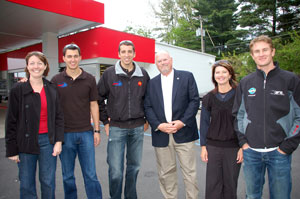 The U.S. House today has passed a measure seen as important because it extends renewable energy production and investment tax credits has cleared its latest hurdle. H.R. 6049, the Renewable Energy and Job Creation Act of 2008, got through the U.S. House by a 263-160 margin.
The U.S. House today has passed a measure seen as important because it extends renewable energy production and investment tax credits has cleared its latest hurdle. H.R. 6049, the Renewable Energy and Job Creation Act of 2008, got through the U.S. House by a 263-160 margin.
This story posted on RenewableEnergyWorld.com says if it clears Congress, it will mean billions of dollars for alternative energies:
H.R. 6049, is a US $54 billion tax extenders package that contains an extension of the federal production tax credit for wind power (PTC) through December 31, 2009 and contains a new small-wind investment tax credit (ITC). The bill also extends the 30% investment tax credit for solar energy property and qualified fuel cell property, and the 10% investment tax credit for microturbines through the end of 2014. Biomass, geothermal, landfill gas and other technologies receive a three-year extension under the legislation.
Passing through the House doesn’t mean it’s a sure thing to become law. There is already opposition in the U.S. Senate and President Bush has threatened to veto the measure.
Stay tuned… we’ll keep you updated.


 Biodiesel-powered vehicles were the dominating force during this year’s Challenge X… a four-year engineering competition with 17 university teams from across North America developing General Motors vehicles using alternative energies.
Biodiesel-powered vehicles were the dominating force during this year’s Challenge X… a four-year engineering competition with 17 university teams from across North America developing General Motors vehicles using alternative energies.  The Mississippi State team designed a through-the-road parallel hybrid electric vehicle powered by a 1.9L GM direct injection turbo diesel engine fueled by bio diesel (B20). It achieved a 38 percent increase in fuel economy over the production vehicle on a modified urban test cycle.
The Mississippi State team designed a through-the-road parallel hybrid electric vehicle powered by a 1.9L GM direct injection turbo diesel engine fueled by bio diesel (B20). It achieved a 38 percent increase in fuel economy over the production vehicle on a modified urban test cycle. The 2008 Indy Pace Car corvette wasn’t the only shiny new toy to check out at the giveaway this morning. The
The 2008 Indy Pace Car corvette wasn’t the only shiny new toy to check out at the giveaway this morning. The  I caught up with Indiana Corn’s Mark Walters again, as well as ICMC’s Mike Shuter (pictured), the council’s President and a Frankton, IN farmer. We talked about the new mobile marketing unit, the truth about ethanol as they see it and how IN corn fits into the ethanol industry. You can listen to my interview with Mark and Mike here: [audio:http://www.zimmcomm.biz/epic/shuter-walters-indy.mp3]
I caught up with Indiana Corn’s Mark Walters again, as well as ICMC’s Mike Shuter (pictured), the council’s President and a Frankton, IN farmer. We talked about the new mobile marketing unit, the truth about ethanol as they see it and how IN corn fits into the ethanol industry. You can listen to my interview with Mark and Mike here: [audio:http://www.zimmcomm.biz/epic/shuter-walters-indy.mp3]
 The
The  Taking the 2008 Corvette is fun… and a bit dangerous. Tom Severino will promise you that. Tom is the Vice President and Market Manager of Emmis Indianapolis radio, the parent company of Hank FM. I spoke with Tom about Hank FM’s joint effort with the
Taking the 2008 Corvette is fun… and a bit dangerous. Tom Severino will promise you that. Tom is the Vice President and Market Manager of Emmis Indianapolis radio, the parent company of Hank FM. I spoke with Tom about Hank FM’s joint effort with the  Well winners, really. And no, they’re not the two cute girls to the right. They were so cute though that I had to use their picture. It was Darron Stewart and his two sons that had brought the magic touch from Carmel, IN to a certain red buzzer. The troupe won a 2-year lease to a 2008 Indy pace car corvette at this morning’s special giveaway. The giveaway was the final event in a month-long promotion to raise awareness of ethanol.
Well winners, really. And no, they’re not the two cute girls to the right. They were so cute though that I had to use their picture. It was Darron Stewart and his two sons that had brought the magic touch from Carmel, IN to a certain red buzzer. The troupe won a 2-year lease to a 2008 Indy pace car corvette at this morning’s special giveaway. The giveaway was the final event in a month-long promotion to raise awareness of ethanol.  There’s no question for the
There’s no question for the  Two more biodiesel producers and a marketer have joined the ranks of those that are meeting a strict fuel quality assurance. BQ-9000 is a voluntary fuel quality assurance program, overseen by the National Biodiesel Accreditation Commission (NBAC) and adopted by the National Biodiesel Board and the Canadian Renewable Fuels Association.
Two more biodiesel producers and a marketer have joined the ranks of those that are meeting a strict fuel quality assurance. BQ-9000 is a voluntary fuel quality assurance program, overseen by the National Biodiesel Accreditation Commission (NBAC) and adopted by the National Biodiesel Board and the Canadian Renewable Fuels Association.  The Crystal Flash at Rangeline in Carmel, IN was the first gas station in the Indianapolis metro area to offer E85 fuel, and that was several years ago. Andy Batt, the Vice President of Merchandising for Crystal Flash fuel retailer, says E85 sales make up about four to five percent of all gallons of fuel sold at the Rangeline location. He says ethanol pump promotions like the one the
The Crystal Flash at Rangeline in Carmel, IN was the first gas station in the Indianapolis metro area to offer E85 fuel, and that was several years ago. Andy Batt, the Vice President of Merchandising for Crystal Flash fuel retailer, says E85 sales make up about four to five percent of all gallons of fuel sold at the Rangeline location. He says ethanol pump promotions like the one the  A man entrenched in the oil business is looking to the wind for the future.
A man entrenched in the oil business is looking to the wind for the future.